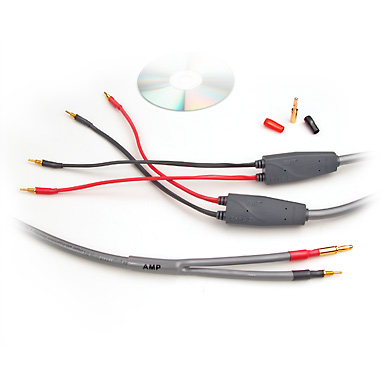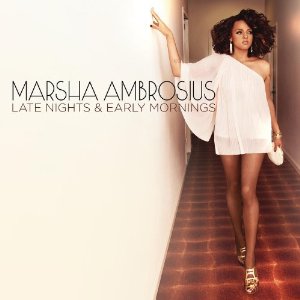MIT EXp2 Speaker Cables
| MIT EXp2 Speaker Cables |
| High value, low cost |
|
|
|
October, 2011 |

When it comes to buying new audio equipment I’m frugal. I, like many of you, have limited funds to purchase new gear with. When I set out to replace or add a component to my system I seek out products that perform at the apex of the price-to-performance pyramid. I’m looking for products with high bang for your buck (as dictated by my wife and my own frugality).
For us audiophiles the concept of diminishing returns is not new, but for those of you who have forgotten, it means that benefits beyond a certain point fail to increase in proportion to the amount of money spent. Up for review is a cable that promises to perform at the pinnacle of the price-to-performance mountain top; high performance at a value price. Enter the MIT EXp2 speaker cable.
The EXp2
The EXp2 ($179/8ft pr) is the middle cable in the EXp line of MIT speaker interfaces. It features MIT’s Parallel Network Technology which provides 4 articulation poles and is said to improve performance. The cable itself is grey, flexible and uses four conductors with OFC & P.E. insulation. The main cable terminates into an interface at each end. Each interface has a pair of six inch red (+) and black (-) solid core cooper leads terminated with gold-plated Pin-Base iconn connectors which thread onto bananas, spades or flexipins. Bananas are standard and they held on tightly even after repeated plugging and unplugging.
MIT Technology
The EXp2 is built around MIT’s Parallel Network Technology. The technology is contained in the aforementioned “interfaces.” If you’ve been around audio for any period of time you’ve seen the little pods, er interfaces that adorn MIT cables. Parallel Networks use articulation poles which are points along the audio bandwidth where all the cables’ properties; capacitance, inductance and resistance, are properly balanced. Increasing the number of articulation poles increases the naturalness of music.
It’s more complicated than that but at some point during the writing of this review I realized I was pulling my hair out trying to explain the technology. I spent so much time on the technology I was losing sight of the goal: music enjoyment. I refocused my attention back to the music and decided to let the volumes of published information on MIT technology do the heavy lifting for me. To that end I’m going to assign you some homework. Don’t sigh. It’s good homework. After you’re done reading this review checkout fellow Stereo Times contributor Moreno Mitchell’s April 2010 review of MIT’s Oracle MA-X Digital AES/EBU cable. In his review he does a good job summarizing some of the trickle down technology within the EXp line. More information about Parallel Network Technology and other MIT technologies can be found on their website, here and also here.
The Company
The major brain behind MIT is Bruce Brisson. His roots are deep in audio going back to the 1970’s. His commercial success began in 1981 when he licensed several designs and patents to Monster Cable. Monster Cable continues to use several of these designs to this day, including “Bandwidth Balanced”, “Phase Correct” windings, and “Time Coherent windings. In 1984, Bruce founded Music Interface Technologies (MIT), on a mission to take wire to a new level.
Interview with MIT
To understand MIT’s design goals and the technology involved in bringing the EXp line to market I contacted Gavin Fish, MIT’s Global Sales Manager. Surprisingly he had a lot of information to share. I say surprisingly because let’s face it, the EXp2 is not the most expensive cable in MIT’s vast arsenal of high-end audio cables. I spoke to Gavin on the phone and had several email exchanges with him during which time he shared important and interesting nuggets of information about the EXp line. You can read our email conversation below:
– Thomas Turner (TT): Who is the target audience for MIT’s EXp2 speaker cables?
– Gavin Fish (GF): The EXp series of speaker interfaces and interconnects is targeted to audiophiles who want to get the most out of their systems without spending large quantities of money. Though they are considered by many as “entry level” or “low end,” they are hardly that. While I can see this point of view when you compare them to our top-of-the-line interfaces such as the Oracle MA-X2 HD, this opinion does not hold up when you compare them to other cables in the same price range.
TT: What ratio (%) of the audio budget does MIT recommend an audiophile spend on audio cables and accessories?
GF: At MIT, we suggest that an audiophile not spend more than about 20% of the total system cost on speaker cables, interconnects, and power cords. With this rule of thumb in mind, it should be easy for the audiophile to determine if their system is a good fit for the EXp 2. This is only a rule of thumb, and we realize that there are many great deals on components and loudspeakers that “outperform their price,” but we feel that in general this is a good place to start.
TT: Does the EXp2 speaker cable contain any trickle down technology from MIT’s higher end cables such as the Shotgun, AVt MA, Magnum MA, or Oracle MA-X’s?
GF: The short answer is yes. Most every technological breakthrough that we’ve made here at MIT has come in our highest end cables. Over time we are able to take the lessons we learn by developing the reference level products and apply them on down the line. New manufacturing techniques are usually discovered or developed to help us do this. For example, the technology found in the EXp 2 was originally designed for the Oracle line.
TT: Does MIT have a “house” sound and if so, is it built into the EXp2’s?
GF: This is a hard question to answer and one that is asked rather a lot. The idea for any audio company is to not have a “house sound.” From the perspective of a cable manufacturer, we look at our job as one of solving problems. We understand that “just wire” audio cables act as inefficient low pass filters. We also understand that all “just wire” audio cables are all “networks” (LCR, ports, terminals). Therefore, we look at these problems and engineer solutions for them. So, by improving a cable’s ability to transfer energy, we are able to predict how the cable will improve the overall system sound. Does this leave a house sound or “signature?” Well, perhaps it can be described that way. But a better way to describe it is to say that the cable is more revealing of the rest of the components.
Listening Material
Before we get into the meat of the review, let’s get some details out of the way. All reference tracks used in this review are sourced from my trusty Squeezebox Touch. They are at least 16/44.1kHz FLAC, AIFF, or WAV files, unless otherwise noted. I do most of my critical listening on my living room sofa, however there are times when I listen to music seated at my computer while working or browsing the internet. I don’t consider this critical listening by any measure but you’d be surprised at how a reference quality playback system can reveal musical surprises—even while not sitting in the “sweet spot.“
For this review I used several familiar albums that have served me well and are adept at distinguishing sonic characteristics of components and audio cables alike. A few personal favorites areLate Night & Early Mornings [J-Records], the latest album from the English born beauty Marsha Ambrosius—of Floetry fame. Her album is soulful and filled with great harmonies and textures. Is That You? [Universal Music Austria] from Norwegian artist Rebekka Bakken. Her uniquely rich voice graces a wonderfully layered and musical album with top notch production and well composed eclectic songs. Other albums include Marvin Gaye’s 1973 classicLet’s Get It On [Motown], Adele’s candid 21 [Columbia] album, Norah Jones’s The Fall [Blue Note Records], Ryan Adams 29 [Lost Highway], and various tracks from Sade, E-40, Paloma Faith, Kings of Leon, Linkin Park, Aaron Lewis, Portico Quartet, Sungha Jungand others.
Round 1
I had a couple low buck cables on hand to compare the EXp2 to: a pair of Monoprice cables and my current speaker cables the AudioQuest SA-20. First up was the 16 cent a foot, 16 gauge Monoprice speaker cable. It wasn’t a contest and to put it lightly, the EXp2 destroyed the Monoprice speaker cables. Soundstage, clarity, rhythm, weight and any other descriptive audio characteristic you can think of were better through the EXp2. The EXp2’s victory was so complete I retired the Monoprice cables.
AudioQuest’s SA-20 promised to put up a better fight. The SA-20 is discontinued now, but for such an inexpensive and simple cable it was advanced. It featured AudioQuest’s Functionally Perfect Copper (FPC) and their take on Litz construction which they called Hyperlitz.
Functionally Perfect Cooper (FPC) is drawn using the Ohno Continuous Casting (OCC) process. The Ohno Continuous Casting (OCC) process uses a single crystal that is unidirectional, free of impurities, is flexible and fatigue and corrosive-resistant, has low electric resistance, and other benefits said to yield sonic benefits.
Conventional Litz cable construction was invented to prevent skin-effect induced power loss in high-frequency applications. Conventional Litz construction uses multiple individually insulated strands arranged so that no matter how big the cable, skin-effect is no more than it would be for a single strand. In addition to conventional Litz benefits, Hyperlitz attempts to prevent other distortions associated with the use of multiple strands. Another problem plaguing speaker cables is magnetic interaction. Hyperlitz virtually eliminates magnetic interaction and ensures that the electrical characteristics of each strand are constant and unchanging over the length of the cable. I can’t verify what is or isn’t going on in the cable, but these combined attributes make SA-20 a solid overall performer with a great track record.
Round 2 I cued up track 5 “Far Away” on Marsha Ambrosius’s Late Night & Early Mornings [J-Records] album. Through the EXp2 this record is oh so smooth with the perfect amount of depth and presence. Every shade and nuance of her powerful voice comes through effortlessly. I have become quite familiar with every gradation of her sultry voice and well textured album since drafting it into heavy rotation. Something special IS going on inside the EXp2’s little interfaces.
I cued up track 5 “Far Away” on Marsha Ambrosius’s Late Night & Early Mornings [J-Records] album. Through the EXp2 this record is oh so smooth with the perfect amount of depth and presence. Every shade and nuance of her powerful voice comes through effortlessly. I have become quite familiar with every gradation of her sultry voice and well textured album since drafting it into heavy rotation. Something special IS going on inside the EXp2’s little interfaces.
Through AudioQuest’s SA-20 Marsha’s voice was still sultry and powerful, but it took on a slightly more sterile some would call it accurate or dry character. The old adage “you don’t know what you’re missing until you hear it” holds true here. Ok, the phrase may not go exactly like that, but you get the picture. In the wrong system, listening fatigue could be a problem with the SA-20. The SA-20 put up an adequately wide and deep soundstage, although smaller than EXp2’s.
The SA-20 lacked the musicality of the EXp2. I noticed that if I was listening to music through the EXp2, it was difficult to stay focused on taking notes. I was more deeply engrossed in the sensation of music. I got no such feeling while listening through the SA-20. I found myself merely taking notes, not becoming engaged in the music. This was a clear sign the SA-20 was missing some of the magic the EXp2 had.
To highlight the differences between the two cables, I listened to as many albums as I could find. I conducted several listening sessions swapping back and forth between the EXp2 and SA-20. These sessions allowed me to confirm the sonic characteristics of both cables.
I was able to confirm that in my system at least, the SA-20 is a bit dry sounding. It’s not musically involving as the EXp2. The EXp2 had better timing, bass definition and speed. The pace of music as well as bass through the SA-20 was slower as if it was struggling to keep up.
 For the last comparison I put on another favorite of mine, Rebekka Bakken. Her album Is That You? [Universal Music Austria] is a great mix of songs. The EXp2 accurately conveyed the subtle movement of air through the passages of the saxophone on Track 10, “Innocence.” Through the SA-20, air was still there, but the decay was shorter; put another way, it had less resolution and transparency. Emotional drive was also lacking in the SA20. Track 10 is superb at invoking emotion and is loaded with all sorts of ambiance and spatial goodies to go along with a smooth and grainy saxophone solos. If you’ve heard this track, you know what I mean. I didn’t get the same sense of envelopment and feeling while listening through the SA-20. Throughout listening to Rebekkas’ album the EXp2 had better clarity which brought the music into my listening room with greater realism and subtlety.
For the last comparison I put on another favorite of mine, Rebekka Bakken. Her album Is That You? [Universal Music Austria] is a great mix of songs. The EXp2 accurately conveyed the subtle movement of air through the passages of the saxophone on Track 10, “Innocence.” Through the SA-20, air was still there, but the decay was shorter; put another way, it had less resolution and transparency. Emotional drive was also lacking in the SA20. Track 10 is superb at invoking emotion and is loaded with all sorts of ambiance and spatial goodies to go along with a smooth and grainy saxophone solos. If you’ve heard this track, you know what I mean. I didn’t get the same sense of envelopment and feeling while listening through the SA-20. Throughout listening to Rebekkas’ album the EXp2 had better clarity which brought the music into my listening room with greater realism and subtlety.
The SA-20 is an excellent all around performer. It unlike the Monoprice cable was not outclassed by the EXp2, however the EXp2 did shine brighter in the end.
Conclusion
I thoroughly enjoyed my time with the EXp2. It was a great performer and consistently sounded better than my AudioQuest SA-20 cables. Where the SA-20 fell short, the EXp2 filled in and even elevated my listening experience. Is the EXp2 without peer? No way. I’ve heard more realistic sounding cables with better bass definition, clarity, and sound staging—MIT itself has many to choose from. What we have in the EXp2 is an overachieving speaker cable with trickle down technology from its more expensive brethren. Among its peers, the $179 EXp2 is one of the best bangs for your buck.

![]()
Company Information:
Price: $179.00 per 8-foot
MIT Cables
4130 Citrus Ave., Suite 9
Rocklin, CA 95677
Phone: 916-625-0129
Fax: 916-625-0149
E-mail: info@mitcables.com
http://www.mitcables.com
![]()
Don’t forget to bookmark us! (CTRL-SHFT-D)
Stereo Times Masthead
Publisher/Founder
Clement Perry
Editor
Dave Thomas
Senior Editors
Frank Alles, Mike Girardi, Key Kim, Russell Lichter, Terry London, Moreno Mitchell, Paul Szabady, Bill Wells, Mike Wright, Stephen Yan, and Rob Dockery
Current Contributors
David Abramson, Tim Barrall, Dave Allison, Ron Cook, Lewis Dardick, Dan Secula, Don Shaulis, Greg Simmons, Eric Teh, Greg Voth, Richard Willie, Ed Van Winkle, and Rob Dockery
Music Reviewers:
Carlos Sanchez, John Jonczyk, John Sprung and Russell Lichter
Site Management Clement Perry
Ad Designer: Martin Perry





Be the first to comment on: MIT EXp2 Speaker Cables